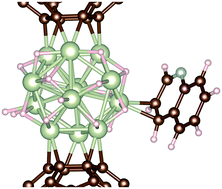Chemoselective reduction of quinoline over Rh–C60 nanocatalysts†
Abstract
The design and engineering of heterogeneous nanocatalysts that are both highly active and selective for hydrogenation reactions constitute a crucial challenge. In that context, herein a series of Rh–C60 nanocatalysts have been synthesized via the decomposition of an organometallic rhodium complex in the presence of fullerene C60 under a H2 atmosphere. Rhodium atomically dispersed or rhodium nanoparticles on Rh–C60 spherical fulleride particles were produced by tuning the Rh/C60 molar ratio. Significant charge transfer between rhodium and C60 was evidenced through Raman and X-ray photoelectron spectroscopy, which indicates electron-deficient Rh species. The resulting heterostructured nanomaterials were applied successfully in the catalytic hydrogenation of quinoline, exhibiting excellent activity and producing selectively the partially hydrogenated product, 1,2,3,4-tetrahydroquinoline. Density functional theory (DFT) calculations show that the hydride coverage of the Rh NPs plays a key role in the adsorption modes of quinoline and 1,2,3,4-tetrahydroquinoline on the surface of the NPs, and that these adsorption modes are modulated by the presence of fullerene C60, thus affecting the activity and selectivity obtained with this rhodium based catalyst.

- This article is part of the themed collection: 2019 Catalysis Science & Technology HOT Articles


 Please wait while we load your content...
Please wait while we load your content...